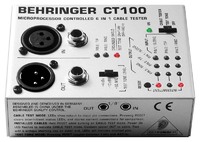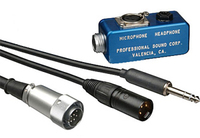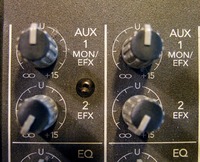Get into the habit of cleaning the inside of your headphones with an alcohol prep pad (readily available in the drugstore for those who self-inject; no prescription needed; and only a couple dollars for a box of 100 or more). You do not even want to think about what kinds of germs can flourish in a sweat fed environment.
Headphone cords are naturally way too long. If it is a straight cable, then fold it up into a neat bundle and secure it with some wraps or cable ties. (Don't use an adhesive tape that will leave sticky residue.) If you are blessed with a coiled cable, here is a trick for managing it. Tie a cord at the start of the coils, and thread that cord through the center of the all of the coils. Tie it off at the other end. That will prevent the coiled cord from stretching out. Should you ever need the extra length, just untie one end of the cord.
Once you have acquired your headphones, the next step is to learn how to use them.
Adjust your listening volume so that normal dialogue is smack in the middle of your comfort zone. A loud burst of dialogue, such as a shout or a scream, should be slightly uncomfortable (but not painful) to hear. Loud enough so that, if you were on a telephone, you would want move the handset a little bit away from your ear.
If an actor barely whispers, you should reflexively want to concentrate hard or make it louder.
When you using a mixing panel, you can adjust your headphone volume relative to the tone generator. Turn on the tone, and set it so that it reads at zero on the mixer. Then gradually raise the headphone volume until the tone is slightly uncomfortable, just like loud dialogue. Remember, than when you mix audio levels, zero should NOT represent normal conversation. Those levels should be several dB below zero.
It is natural for every individual to set their headphone listening level to a different physical volume knob setting. Our hearing and sensitivity vary from person to person. It is also normal for a mixer to reset his or her headphone volume throughout the day. Our hearing is more sensitive in the mornings, and becomes fatigued as the day wears on. Indoor locations tend to be quieter, so we need less volume. Outdoors, we tend to boost our listening levels. What matters in the long run, though, is that we maintain normal dialogue in our comfort zone.
 When you set your headphone volume too loud, you tend to mix your audio levels too low. On the same token, if you listen at too low of a volume, you will end up recording way too hot.
When you set your headphone volume too loud, you tend to mix your audio levels too low. On the same token, if you listen at too low of a volume, you will end up recording way too hot.
The CT100 is not only a versatile cable tester,
but also provides mic or line level test tones.
You can read more about it here.
Won't the meter on the camera or mixing board indicate proper recording levels? Yes, they will, but you should not be watching them too closely. It is akin to driving a car: if you spend all of your time watching the speedometer, you will hit a tree. You drive by watching the road around you, and gauge your speed by your surroundings. You only glance down at the speedometer now and then (usually when a cop car is present).
The same should hold true for adjusting your audio levels. Keep your eyes on the actors, and pay attention to their body language. That will tell you who is about to talk, and warn you of shouts, sneezes, and coughs. Note the position of actors relative to your mics. Are they right under the boom, or off of their marks. Where are they relative to other mics on the set?
Do not wait until you HEAR a problem. Learn to observe and anticipate. When you drive, you do not watch your foot move from gas to brake pedal. When you mix, you should not watch your own fingers either.
Use your eyes to keep track of the scene, and allow your ears to prompt you into raising or lowering the audio levels.
The boom operator also needs to hear the soundtrack, though not as critically as the Sound Mixer. Because a boom operator is in the middle of the set, his headphone volume may be set lower. Sometimes a boomperson needs to be able to hear possible warnings on the set from other crew members (watch out for the dolly, etc.).
 Too often, novice soundpeople restrict the boomperson's headphone feed to only hear what the boom mic is picking up. That is a bad practice and should be avoided. What the boomperson NEEDS to hear is the boom mic along with all of the other mics that are in play on the set.
Too often, novice soundpeople restrict the boomperson's headphone feed to only hear what the boom mic is picking up. That is a bad practice and should be avoided. What the boomperson NEEDS to hear is the boom mic along with all of the other mics that are in play on the set.
On most shoots, a professional sound mixer will use more than one mic in order to cover distance across the set, or to solve boom shadow issues close to walls, etc. But when two mics (recording to the same audio channel) are open at the same time, and can pickup the same sound, a phasing issue occurs that causes the audio to become very hollow and thin. One of the offending mics must be faded down; and the other mic needs to compensate. Or, one of the mics (the boom) needs to be angled away from the other mic.
The boom operator must be able to hear the presence of any other open mics, so that he or she does not accidentally "double mic" the actor in question. (And some folks believe that being a boomperson is brainless.)
 Specialized mixing panels used for film and video production may offer a dedicated headphone output for the boom operator. Most of the time, though, the less expensive (but still good quality) mixing panels from Mackie or Behringer do not have a special headphone output separate from the soundmixer's own headphone connection. But they DO have Aux outputs for monitor mixes.
Specialized mixing panels used for film and video production may offer a dedicated headphone output for the boom operator. Most of the time, though, the less expensive (but still good quality) mixing panels from Mackie or Behringer do not have a special headphone output separate from the soundmixer's own headphone connection. But they DO have Aux outputs for monitor mixes.
Plug the headphone extension cable (feeding your boomperson) into the post-fader Aux Send of the mixing board. Most boards have a "master" Aux Send volume control, which you can use as a de-facto headphone volume control for your boom operator. Note that the Aux Send connection is usually ¼-inch MONO, so make sure you have the necessary mono-stereo adapter plug or a custom cable to keep audio in both sides of the headphones.
In addition to the master Aux Send volume control, there are individual Aux controls for every input. Normally, just set these to the default detent or middle position. Some inputs, such as an external tone generator, audience mics, or SFX mics do NOT need to be monitored by the boomperson. You can turn the Aux controls for those inputs to the low end. But make sure that the mics on the set affecting dialogue are sent out to his headphones.
On a mixing board, you will see two types of Aux Send. It may a switch, or there may be more than one Aux Send with labels. Pre-Fader Aux Send means that the only knob affecting the monitoring is the individual Aux knob on each input. What that means is that it does not matter whether or not the main faders for a given mic is open or closed down; the only knob that controls the audio flow to the monitor (Aux Send) is the Aux knob. If the Aux knob is open, that mic is open in the headphones. If the Aux knob is closed, then that mic will not be heard in the headphones. It matters not what you are doing in the main mix. It is as every mic had a Y cable connecting two separate mixing boards on your cart; they function completely independent of each other.
As you can imagine, sending the boomperson a Pre-Fader Aux Send would be quite distracting, since every mic on the set would be "open" at all times, even if the Sound Mixer was not deploying it.
When Post-Fader Aux Send is selected, the only sound that makes it up to the Aux Send controls is what passes out of the controlled fader of each input. If the sound mixer closes a mic, then no signal is allowed to enter the Aux Send. When that mic is open, then only that relative amount of volume is sent to the Aux.
Think of your home sprinkling system. If the main water valve is closed, then no water reaches the sprinklers, irregardless of whether the sprinkler valve is open or not. Open the main valve, and then the knob on the sprinkler determines the water flow.
Post-Fader Aux Send allows the boom operator to hear the live mix. When needed, the version of the live mix going to the boomperson can be modified by the individual Aux controls, such as keeping the non-important (to the boomperson) audio minimized. On the other hand, the sound mixer can wig-wag the Aux volume of a particular mic to call the boomperson's attention to it, perhaps to warn him of a hidden mic in the set.
